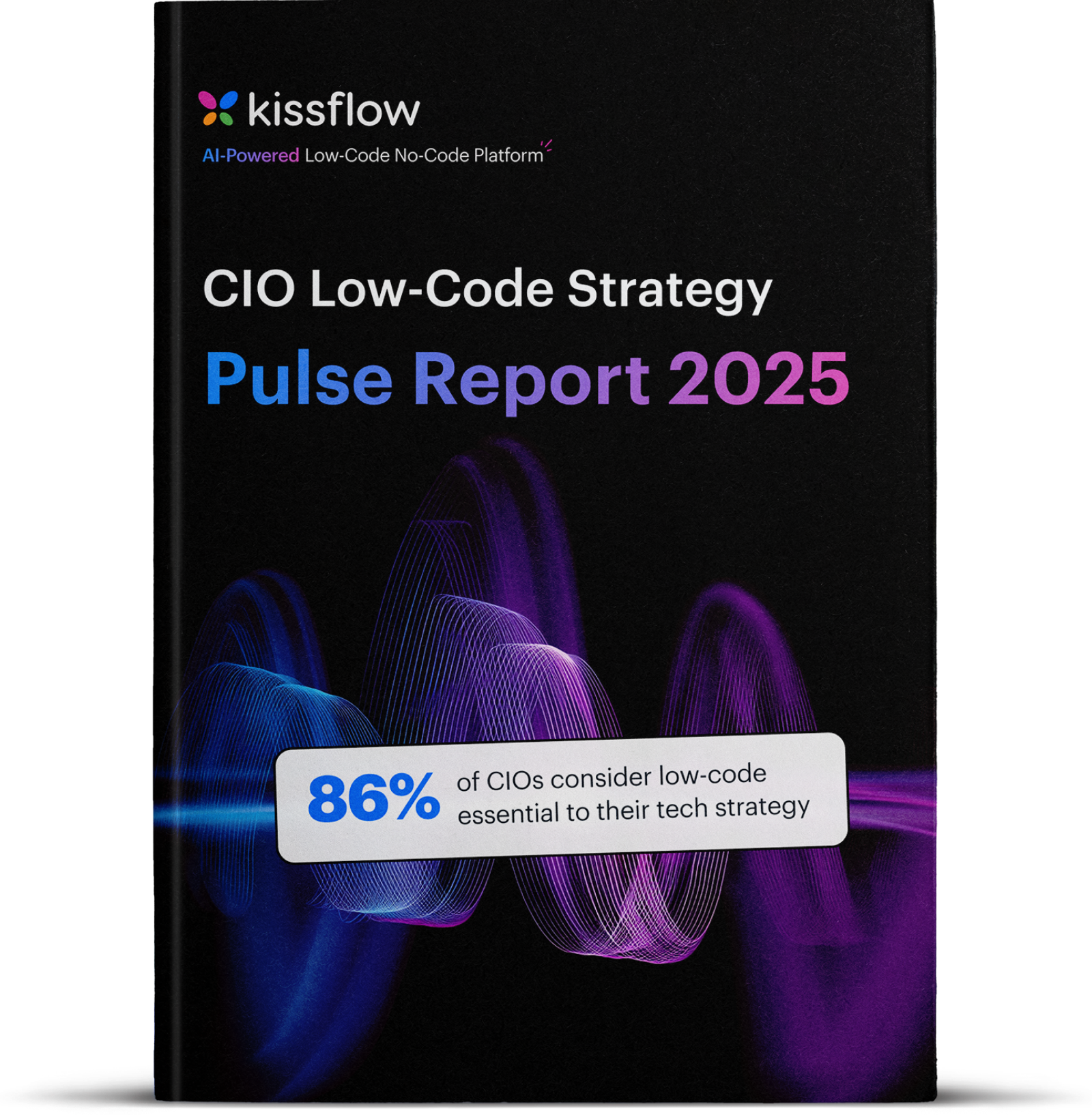
How Enterprise IT Teams Can Prioritize Business Goals in Application Development
Application development plays a central role in enterprise IT, driving business success. However, aligning development priorities with organizational goals is often a challenge. Misaligned priorities can result in wasted resources, delayed timelines, and underperforming applications that fail to deliver value. Addressing this alignment is not just a technical task but a strategic necessity for enterprises aiming to achieve long-term growth and operational excellence.
By focusing on clear frameworks, fostering collaboration between IT and business teams, and adopting the right tools, enterprises can ensure that their application development efforts directly contribute to their strategic goals. This article explores key strategies, potential challenges, and how platforms like Kissflow can support organizations in bridging the gap between IT initiatives and business objectives.
Understanding enterprise application development priorities
Enterprise application development is not just about building software but creating solutions that align with organizational goals while addressing immediate and future needs. Prioritizing the right aspects of development ensures that IT efforts support business objectives effectively. Below is an exploration of the key priorities that form the foundation of enterprise application development platform.
Speed and agility in delivery
Swift responses to market changes are essential for maintaining competitiveness. Enterprises must quickly develop and deploy applications to address evolving customer demands, support new business initiatives, and tackle emerging challenges. Adopting agile methodologies, automating repetitive tasks, and using pre-built templates or frameworks can accelerate development timelines. For instance, when launching a new product, having a customer portal ready on time ensures seamless customer interactions, aligning IT timelines with critical business goals.
Security and compliance
In an environment of increasing cyber threats and stringent regulations, prioritizing security during application development is critical. Every application must protect sensitive data, block unauthorized access, and comply with relevant legal and industry standards. This commitment to security reduces the risk of breaches, financial losses, and reputational damage. IT teams should embed security measures throughout the development lifecycle, from design to deployment. For example, applications processing customer payments must adhere to PCI DSS standards to ensure secure transactions and maintain trust.
Scalability and flexibility
As organizations grow, their applications must scale to accommodate more users, larger workloads, and evolving business processes. Scalability ensures that applications perform reliably under increased demand, while flexibility allows them to adapt to new requirements without significant redevelopment. For example, an e-commerce platform should handle high-traffic periods, like holiday sales, without performance issues. Leveraging scalable architectures, such as microservices and cloud-based solutions, equips IT teams to meet future demands efficiently.
Integration with existing systems
Most enterprises operate a mix of legacy systems and modern applications, prioritizing smooth and easy integration. New applications must work harmoniously with existing infrastructure to maintain consistency and eliminate silos. For example, an HR management tool must integrate with payroll and benefits systems to ensure a unified flow of information. APIs, middleware, or enterprise service buses often play a key role in facilitating this integration, reducing redundancies, and providing accurate, up-to-date data across the organization.
Challenges in aligning application development with business goals
Bridging the gap between IT priorities and business objectives is crucial for the success of enterprise application development. However, several challenges can disrupt this alignment. Addressing these obstacles requires careful planning and collaboration throughout the development lifecycle.
Communication gaps
Poor communication between IT teams and business units is among the most common barriers to alignment. When goals and requirements are unclear, IT teams may build applications that address technical specifications but fail to meet business needs. For example, if business leaders fail to communicate the importance of improving customer experience, the resulting application might prioritize back-end efficiency while neglecting user-facing features. This misalignment leads to applications that deliver limited value, reducing their overall effectiveness. Regular communication channels, such as cross-functional meetings and collaborative platforms, are essential to bridging this gap.
Conflicting objectives
IT and business teams often have different priorities, creating friction during application development. IT teams may focus on cost optimization, system stability, and long-term scalability, while business units prioritize short-term growth, innovation, and time-to-market. These differing objectives can cause delays or derail projects without a shared understanding of organizational goals. For example, IT might insist on a comprehensive data integration strategy while business teams rapidly push to release new features. To overcome this challenge, organizations must create a unified development roadmap that balances technical requirements with business outcomes.
Legacy systems
Many enterprises rely on legacy systems that are not designed to integrate with modern applications. These older systems often lack the flexibility to support new technologies, creating bottlenecks that slow development. For instance, a company might struggle to integrate a cloud-based CRM with an outdated on-premise ERP, leading to inefficiencies and data silos. Modernizing legacy systems or introducing middleware solutions can help alleviate these issues, but these efforts require significant planning and investment. Organizations must prioritize updates to their infrastructure to avoid hindering innovation.
Governance issues
Effective governance is critical to ensuring that application development aligns with organizational standards and regulatory requirements. However, inadequate oversight can lead to applications that fail to meet compliance standards, exposing the business to financial and legal risks. For example, an application not adhering to GDPR requirements could result in substantial penalties for data privacy violations. Governance challenges often stem from a lack of clarity around roles and responsibilities and insufficient monitoring during the development process. Establishing clear governance frameworks, supported by tools that track compliance and development progress, can mitigate these risks.
Addressing the challenges
These challenges underscore the importance of a strategic approach to application development. Organizations can address these issues by fostering open communication between IT and business teams, aligning objectives through collaborative roadmaps, modernizing legacy systems, and implementing robust governance frameworks. By tackling these challenges head-on, enterprises can ensure that their application development efforts align with their broader business goals and deliver measurable value.
Achieving alignment between application development and business objectives requires a focused approach. Organizations can adopt the following strategies to overcome challenges and create meaningful outcomes:
Transparent communication and collaboration
Effective alignment starts with transparent communication between IT and business stakeholders. Regular meetings, feedback sessions, and collaborative platforms create opportunities for both teams to share insights and maintain a unified understanding of objectives. For example, IT teams should have access to business strategy updates to better understand the context behind application requirements.
Introducing fusion teams groups that combine technical expertise with business acumen can improve decision-making and reduce misunderstandings. These teams work closely throughout development, ensuring applications address technical requirements and business priorities. Such collaboration not only enhances efficiency but also builds trust between departments.
Adopt prioritization frameworks
Teams cannot pursue all projects simultaneously, so they must prioritize and allocate resources effectively. Frameworks like priority matrices allow teams to assess competing objectives and determine which initiatives align most closely with organizational goals. These tools rank projects based on expected ROI, customer impact, and alignment with strategic priorities.
For instance, a company might prioritize the development of a customer portal over an internal tool if the portal promises to drive revenue growth and improve customer retention. A structured approach directs resources to initiatives delivering the highest value.
Develop outcome-oriented roadmaps
Roadmaps provide clear direction by linking development milestones to specific, measurable business outcomes. For example, an IT team tasked with building a sales tracking app can set milestones tied to improved sales pipeline visibility and faster deal closures.
Outcome-oriented roadmaps give all stakeholders a shared vision of success, making it easier to track progress and adjust priorities as needed. These roadmaps also help teams evaluate the broader impact of their work, ensuring that development efforts align with key organizational goals such as customer satisfaction or operational efficiency.
Leverage agile methodologies
Agile methodologies emphasize flexibility, iterative progress, and collaboration, making them ideal for aligning application development with dynamic business needs. Breaking development into smaller sprints allows teams to focus on incremental improvements and adapt quickly to changing priorities.
For example, an agile team working on an employee onboarding application might deliver a basic version within a few weeks, gathering feedback from HR teams to refine the app in subsequent iterations. This approach speeds development and ensures the application evolves based on real-world feedback and changing requirements.
Conduct regular audits and reviews
Teams must continuously monitor application development priorities to align them with business objectives. Regular audits help evaluate progress, identify gaps, and make necessary adjustments. For instance, an audit might reveal that an application lacks integration with critical systems, prompting immediate action to address the issue.
Reviews also provide an opportunity to measure the effectiveness of deployed applications against predefined KPIs. By assessing metrics such as user adoption, system performance, and impact on business processes, teams can ensure that their development efforts deliver the desired results.
Measuring KPIs for application development alignment
Key performance indicators (KPIs) are essential for assessing whether enterprise application development priorities align with organizational goals. They provide a clear picture of progress, efficiency, and impact, helping IT leaders refine strategies and communicate the value of their efforts to business stakeholders. Ensuring IT-business alignment through measurable outcomes is critical to driving success in application development initiatives.
Project delivery timelines
Meeting project deadlines is critical to ensuring applications support timely business decisions. For instance, launching a customer-facing app during a product rollout can make or break its success. Tracking delivery timelines helps teams evaluate their ability to stay on schedule and identify bottlenecks in the development process, which is a key concern in enterprise IT priorities.
Beyond measuring whether teams meet deadlines, this KPI reveals trends over time. Do certain types of applications experience consistent delays? Do specific teams encounter recurring challenges? By analyzing delivery timelines, IT leaders can identify areas for improvement, such as adopting agile practices or automating repetitive tasks to accelerate development cycles. Addressing these challenges directly impacts application development priorities in enterprise by ensuring timely and effective delivery.
Resource utilization efficiency
Efficient use of resources, whether time, talent, or budget, is a cornerstone of successful enterprise application development priorities. This KPI evaluates how effectively teams allocate resources throughout the development lifecycle. For example, do highly skilled developers focus on complex tasks, or do routine activities that the team could automate bog them down? Resource utilization metrics can also highlight imbalances, such as underutilized tools or teams stretched too thin across multiple projects.
By addressing these inefficiencies, organizations can optimize productivity and direct resources toward high-priority initiatives that enhance IT-business alignment. Ensuring developers work on strategic tasks rather than repetitive ones supports enterprise IT priorities, making application development more agile and responsive.
Business impact metrics
The ultimate measure of success for any application lies in its contribution to business outcomes. This KPI evaluates how effectively an application drives revenue growth, improves customer satisfaction, or enhances operational efficiency all of which are central to enterprise application development priorities.
These metrics tie closely to the application's intended purpose. For example, if teams design an internal tool to streamline expense reporting, they can measure its success by reduced processing time and fewer errors. Business impact metrics directly link IT efforts to organizational goals, reinforcing IT-business alignment and demonstrating the tangible value of application development investments.
Application performance and uptime
Applications must perform reliably to meet user expectations and maintain operational continuity, a key factor in enterprise IT priorities. This KPI measures response times, error rates, and system availability. A high-performing application ensures smooth workflows, minimizes disruptions, and enhances user satisfaction.
Monitoring uptime and performance also helps identify potential issues before they escalate. For example, if a customer portal experiences slow response times during peak usage, IT teams can address the problem proactively, preventing user frustration and potential revenue loss. Regular performance evaluations ensure that applications align with enterprise application development priorities and provide consistent value while supporting broader IT-business alignment.
By tracking these KPIs, organizations can ensure that their application development priorities in enterprise remain aligned with strategic business goals, driving efficiency, agility, and measurable success.
How Kissflow simplifies application development alignment with business goals
Kissflow simplifies application development's alignment with business goals by providing a centralized platform that bridges IT and business teams throughout the development lifecycle. Its collaboration tools empower cross-functional teams to work seamlessly, ensuring applications address technical and business requirements. Built-in governance features ensure compliance with organizational standards and industry regulations, reducing risks and enhancing accountability. Real-time dashboards provide decision-makers with actionable insights into progress and performance, allowing for timely adjustments to stay aligned with strategic goals.
Kissflow also supports agile frameworks, enabling iterative development and helping teams adapt to shifting priorities while delivering functional applications. For instance, a manufacturing company used Kissflow’s governance tools and agile workflows to align its supply chain application with goals such as reducing delays and improving supplier collaboration. Kissflow directly ties application development efforts to organizational success by integrating these features. With its comprehensive tools, including collaboration platforms, governance capabilities, and real-time tracking, Kissflow enables enterprises to optimize resources, align initiatives with strategic objectives, and achieve impactful results.
Explore how Kissflow can support your alignment efforts and drive measurable success.
Related Articles











